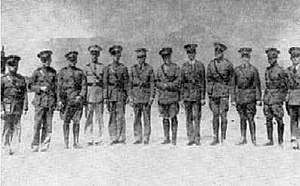1931 Salvadoran coup d'état
The 1931 Salvadoran coup d’état occurred on December 2, 1931. The coup overthrew President Arturo Araujo and led to the establishment of the Civic Directory of El Salvador.
| 1931 Salvadoran coup d’état | |||||||
|---|---|---|---|---|---|---|---|
 The Directory in December 1931. Colonel Osmín Aguirre y Salinas is the fifth from the right and Maximiliano Hernández Martínez is seventh from the right. | |||||||
| |||||||
| Belligerents | |||||||
|
|
| ||||||
| Commanders and leaders | |||||||
|
|
| ||||||
Coup and Directory
The Salvadoran Armed Forces toppled the government of the democratically elected President, Arturo Araujo, the candidate of the Salvadoran Labor Party. During his administration, El Salvador faced political tension and public unrest. Tax reforms also failed to succeed due to resistance from the wealthy class.[1]
The final straw for the coup was an attempt to reduce the military budget which was met by heavy resistance by military officers.[1] With the government being unable to pay wages to military officers, the army staged the coup to remove Arturo Araujo’s administration at 10pm on December 2, 1931.[2]
The military officers established a Directory as a provisional government generally led by General and former Vice President Maximiliano Hernández Martínez and Colonel Osmín Aguirre y Salinas.
Legacy
The Directory was dissolved on December 4 and Maximiliano Hernández Martínez assumed the Presidency as “Acting President”.[3] He would later officially become President on March 1, 1935.
The coup led to the subsequent 1932 Salvadoran peasant massacre where Feliciano Ama and Farabundo Martí lead poor Salvadoran peasants in a communist rebellion against Martínez’s government leading to 25,000 deaths.[4]
The United States did not recognize the legitimacy of Hernández Martínez's rise to power or government due to the 1923 Central American Treaty of Peace and Amity and only recognized his government after his government put down the communist uprising in early 1932.[2]
References
- Grieb, Kenneth J. (1971). "The United States and the Rise of General Maximiliano Hernandez Martinez". Journal of Latin American Studies. 3 (2): 151–172. doi:10.1017/S0022216X00001425. JSTOR 156558.
- Carmelo Francisco esmeralda Astilla (1976). "The Martinez Era: Salvadoran-American Relations, 1931-1944". Louisiana State University and Agricultural & Mechanical College.
- Dur, Philip F. (1998). "US Diplomacy and the Salvadorean Revolution of 1931". Journal of Latin American Studies. 30 (1): 95–119. doi:10.1017/S0022216X97004914. JSTOR 158449.
- "Encuentra aquí información de Oligarquía Cafetalera en Santa Tecla y Santa Ana para tu escuela ¡Entra ya! | Rincón del Vago". 2001-09-17.